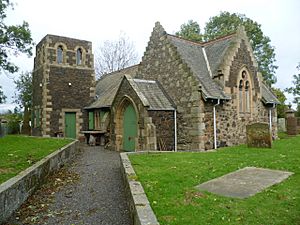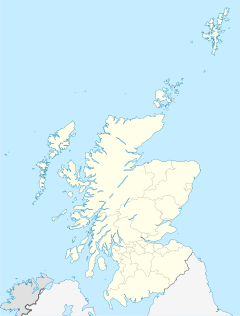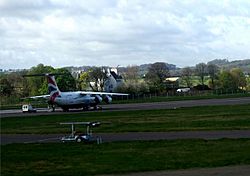Gogar facts for kids
Quick facts for kids Gogar |
|
|---|---|
 Gogar Kirk |
|
| OS grid reference | NT1672 |
| Council area |
|
| Lieutenancy area | |
| Country | Scotland |
| Sovereign state | United Kingdom |
| Post town | EDINBURGH |
| Postcode district | EH12 |
| Dialling code | 0131 |
| Ambulance | Scottish |
| EU Parliament | Scotland |
| UK Parliament |
|
| Scottish Parliament |
|
Gogar is a mostly countryside area in Edinburgh, Scotland. It is located west of the city. You can find it near Gogarloch, Edinburgh Park, and Maybury. The Fife Circle Line train track is just to the north.
Contents
What Does the Name Gogar Mean?
The name Gogar was first written down around 1233. We are not completely sure where the name comes from. It might come from the Scots word "cog" or "gowk." These words mean cuckoo, which is a type of bird. Cuckoos were important in old traditions.
Another idea is that the name comes from "coch." This is a word from an old Celtic language that means red. You can still see "Red Heughs" nearby, which supports this idea. The name Gogar is also part of other local names. These include Gogarloch, Gogarburn, Gogarbank, Gogarstone, and Castle Gogar.
Discovering Gogar's Ancient Past
In 2008, archaeologists explored the land west of Gogar Mains. They were working before the new Edinburgh tram line was built. They found many interesting things from different time periods. These ranged from the Neolithic (New Stone Age) to the Early Middle Ages.
Stone Age Discoveries
The oldest finds were pits from the Neolithic period. Scientists used radiocarbon dating to figure out their age. These pits were used between 3880 and 2487 BC. They also found a special pot called a Beaker vessel. This pot was from the early Bronze Age, around 2146–2015 BC.
Bronze Age and Iron Age Life
Archaeologists also uncovered a Bronze Age ring ditch. This was a circular trench with a structure inside. There was also a palisade trench, which was a ditch for a fence. From the Iron Age, they found two huts. They also found two possible kilns for drying corn. These kilns were from the early Medieval period. Even World War II pillboxes were recorded nearby. All these discoveries show that people lived and worked in Gogar for thousands of years.
Unearthing a Medieval Village
As part of the tram project, archaeologists also dug up parts of the medieval village of Nether Gogar. They found an old well, more corn-drying kilns, and many ditches. People stopped living in this part of Gogar in the mid-1300s. Archaeologists think this might have been because of a serious illness. This illness, known as the Black Death, greatly reduced the population at that time.
Gogar Through the Ages
The first mention of the lands of Gogar was in a document from King William I. This was between 1165 and 1174. The king gave the land at Gogar, Cousland, and Pentland to Ralph de Graham. He was a knight whose family had moved from England.
After this, the land was divided and changed owners many times. An important owner was the Knights of the Hospital of St John.
The Gogar Parish Church
The parish of Gogar was first mentioned in 1247. This was when its church was re-consecrated. This means the church was already important then. In 1529, the church's money was given to Trinity College Kirk in Edinburgh. In 1599, the Gogar parish joined with Corstorphine. After this, the church was no longer used for services.
By the early 1600s, the Logans of Restalrig owned much of the land. They built Castle Gogar.
A Skirmish in 1650
On August 27, 1650, a small battle happened near Gogar. It was between the forces of Oliver Cromwell and General Leslie. General Leslie's army was camped near Gogar Kirk. The ground was very marshy, so the armies could not get close to each other. But both sides fired cannons, causing some injuries.
Cromwell wrote about this event, which lasted for three hours:
We marched west of Edinburgh towards Stirling. The enemy saw us and moved quickly to stop us. The front parts of both armies started to fight. This happened in a place with bogs and difficult paths. We did not know the area well. We lined up, hoping to fight. But we found no easy way because of the bogs. We brought up our cannons. That day, we fired two or three hundred large shots at them. They also fired many shots back at us. This was all that happened between us. We had about twenty people killed and injured, but no officers. The enemy, we heard, had about eighty killed, and some important officers. Since they would not move, and we could not make them, and our bread was gone, we had to get more supplies. So we marched away around ten or eleven o’clock on Wednesday morning.
Later Developments
Sir Robert Liston bought the old village of Gogar in 1830 or 1831. He made improvements to the village and its farms. He is buried in the churchyard.
In 2003, old medieval remains were found near the new headquarters of the Royal Bank of Scotland. They found pieces of pottery, rubbish pits, and animal bones. These were north of the A8 road. These items suggest the area was used for farming in medieval times.
In 2005, the new headquarters for the Scottish Agricultural Science Agency opened. It is located at Gogarbank Farm, near the M8 motorway.
Important Graves in Gogar
Some famous people are buried here:
- James Pittendrigh Macgillivray (1856–1938) is buried with his wife Frieda. He was a Scottish sculptor.
- Thomas Grainger (1794–1852) was an engineer.
Notable Buildings in Gogar
Gogar has several large houses built in the 1700s and 1800s. These include Gogarbank, Over Gogar, and Gogar Park House.
Castle Gogar
The most famous old building is probably Castle Gogar. It is an A-Listed building, meaning it's very important historically. It is a Scottish Baronial L-shaped mansion. William Ayton, a master architect, built it in 1625. He built it for John Cowper and his wife, Helen Skene. John's father had bought the land in 1601.
The castle was built on the site of an older building from the 1300s. You can still see parts of its foundations. The first Castle Gogar (Gogar House) was built around 1300. It belonged to the Forresters of Corstorphine. In the 1500s, Robert Logan of Restalrig owned it. He sold it to Adam Couper in 1601.
The castle was made bigger in the mid-1700s and again in the 1800s. That's when features like the tower and turrets were added. These give it the Scottish Baronial look. The Gibson-Maitland and Steel-Maitland families owned Castle Gogar for over 200 years. It was sold after Brenda Steel-Maitland passed away in 2002. The castle has since been restored. New homes built on the castle grounds helped pay for this work. The castle itself, with its large grounds, was later put up for sale for £2.9 million.
Millburn Tower
Another important historic building is Millburn Tower. This is a large house with many trees around it. It has a tower that looks like a castle (built in 1806). A long, lower building is attached to it.
West Town Development: A New Community

West Town Edinburgh is a planned new housing area. It will be built west of Edinburgh, next to Edinburgh Airport. It is near Gogar and Ingliston. The plan is to build 7,000 homes there. The area covers about 205 acres. It is right next to Edinburgh Airport and the Ingliston Park and Ride. The Edinburgh Tram line goes right through the middle of the site.
This project was once called Edinburgh 205. New Islington Limited developed the idea. Bill Gammell is the chairperson of this company. In April 2021, "Drum Property" bought a major share in the company. Bill Gammell officially announced the plans on December 2, 2021.
Getting Around Gogar: Transport Links
The main depot for the new Edinburgh Trams is located in Gogar. In December 2008, Transport Minister Stewart Stevenson announced a new £43 million train station. This station, called Edinburgh Gateway station, is on the Fife Circle line. It also connects to the Edinburgh Trams. This makes it easy to get to Edinburgh Airport. The station opened on December 11, 2016, and cost £41 million.
The Gogarburn tram stop serves the main office of The Royal Bank of Scotland.
| Preceding station | Edinburgh Trams | Following station | ||
|---|---|---|---|---|
| Edinburgh Gateway towards Newhaven |
Newhaven - Edinburgh Airport | Ingliston Park & Ride towards Edinburgh Airport |





